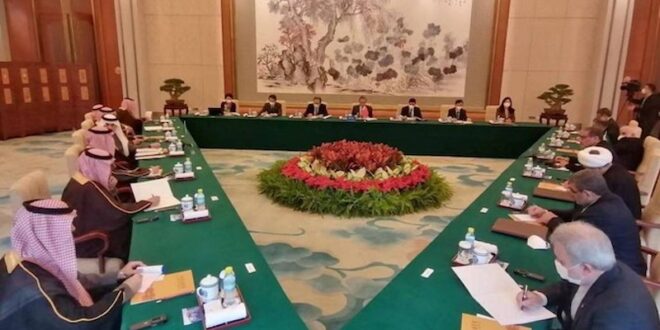Recent developments in the Middle East have cast China as a reliable intermediary and proponent of multilateral dialogue, signalling a departure from Beijing’s typical reluctance to participate meaningfully in conflict negotiations.
Saudi Arabia and Iran’s decision to restore diplomatic relations has raised Beijing’s diplomatic profile and political influence. The agreement between the hostile Middle Eastern powers, facilitated by China and other regional states, was followed by Saudi Arabia’s decision to become a dialogue member of the Shanghai Cooperation Organisation, furthering the perception of China as a peacemaker. The initial agreement was followed by a meeting of the Saudi and Iranian foreign ministers in Beijing on 6 April 2023 where the countries agreed to restore direct flights and deliberated the resumption of government and private sector visits.
Although the detente may not result in normalised relations, China’s diplomatic win signals its increasing willingness and capability to participate in conflict resolution and shape negotiation outcomes in its favour. Beijing’s conflict management approach remains largely driven by its economic interests and desire to project a favourable image. It is characterised by participation without deep involvement. But China is laying the groundwork for deeper involvement and a value and norm-based approach to conflict management.
China’s role as a mediator has become prominent over the last decade. Beijing is more willing and able to influence the outcome of negotiations. Since the announcement of the Belt and Road Initiative (BRI) in 2013, Beijing’s involvement in conflicts has expanded beyond its traditional approach of limited engagement. Before 2013, China rarely participated in international mediation initiatives, preferring to be a neutral onlooker and retain flexibility.
Beijing’s recent diplomatic involvement in the Middle East, Afghanistan, Myanmar and Ethiopia reveal its intention to play a more political and diplomatic role in conflict zones. Still, China’s quasi-mediation approach, where it primarily defends its commercial and political interests, is driven by economic interests and international image. China’s interests in the Middle East, Africa and Asia in the form of the BRI and other trade and energy flows encourage Beijing to participate more actively in shaping the outcome of major diplomatic negotiations.
Take China’s participation in the Saudi–Iran rapprochement, where its energy imports are significant. In 2021, Saudi Arabia supplied China with 18 per cent of its crude oil needs. Beijing is Saudi Arabia’s largest purchaser of oil. Mutual dependence in Saudi–China relations encouraged China to participate as an influential mediator. Similarly, China is Iran’s most important economic partner, compelling Tehran to engage meaningfully in diplomatic negotiations with Saudi Arabia. China’s outsized economic influence in both countries gives it leverage to regulate their political behaviour through quasi-mediation.
China’s lack of historical baggage in the Middle East has also endowed it with the image of being a neutral mediator. Beijing’s BRI ventures, energy dependence and trade relationships also ensure that it remains invested in the long run. Securing a stable Middle East is in China’s interest just like maintaining a stable relationship with Beijing is in Riyadh and Tehran’s interest.
Image-driven considerations also determine China’s participation in conflicts, evidenced by its peace proposals in Ukraine. China’s peace plan in Ukraine has less to do with ending the war and more to do with cultivating its peacemaker image. The plan presented China as a neutral mediator, a position that resonates strongly with developing countries.
French President Emmanuel Macron highlighted China’s potential peacemaker role in the conflict and urged President Xi Jinping to ‘bring everyone back to the negotiating table’. This underlines the growing perception that Beijing’s involvement in mediating conflicts is necessary to produce meaningful resolutions.
While unsuccessful, China’s attempts at mediating in the Middle East between the Taliban and Afghanistan governments and in South Asia between Bangladesh and Myanmar reaffirm its posture as a mediator and provide a contrast to US-led conflict mediation efforts. Beijing has also expanded its diplomatic engagement in Africa, most notably in Ethiopia — a central hub in the BRI. Beijing has offered to mediate disputes at a time when the United States’ relationship with disputing parties in the region continues to deteriorate.
China’s mediation continues to follow a policy of engagement with limited involvement, electing to participate in dialogue without leveraging its position to produce meaningful outcomes. Though this suits Beijing’s desire to project a benign image, mediation policy over the last decade hints at a gradual transformation of China’s posture toward more active political involvement in conflicts.
Beijing’s ability to mediate conflicts is largely driven by its lack of historical baggage, its decision to remain neutral and its ability to offer economic incentives to disputing states. China is keen to leverage its perception of neutrality to become more politically involved in future conflicts.
While China’s involvement in conflicts is still interest-driven, China is poised to develop a value and norm-driven approach to dispute resolution. The Global Security Initiative (GSI) is the most visible attempt at creating an alternative security architecture that sets norms for conflict resolution in the developing world. China has already stated that the Iran-Saudi rapprochement is an example of the GSI in practice.
China’s intention to play a more active and involved role in mediating conflicts ought to force the United States and other regional powers to play a more constructive role in conflict zones. Allowing China to shape the outcome of conflicts permits Beijing to expand its interests and influence at the expense of other states like the United States, India and Japan.
 Eurasia Press & News
Eurasia Press & News


